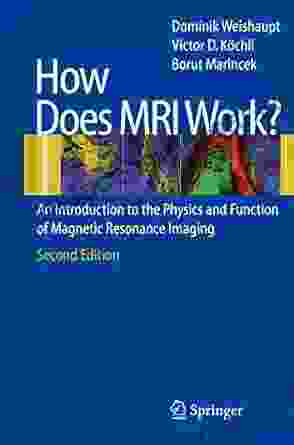An Introduction to the Physics and Function of Magnetic Resonance Imaging

Magnetic resonance imaging (MRI) has revolutionized the field of medical imaging, offering unparalleled insights into the human body. This non-invasive technology utilizes magnetic fields and radio waves to generate detailed images of organs, tissues, and even subtle changes at the molecular level. Whether you're a medical student, a healthcare professional, or simply curious about the inner workings of this transformative tool, this comprehensive guide will delve into the physics and function of MRI, illuminating its principles, applications, and benefits.
At the heart of MRI lies the concept of magnetic resonance, a phenomenon where certain atoms, primarily hydrogen atoms, align themselves with an applied magnetic field. These atoms, like tiny magnets, possess a property known as spin. When a radiofrequency pulse is introduced, these spinning atoms absorb energy and flip their orientation. As they return to their original state, they emit radiofrequency signals that are detected by the MRI scanner.
The emitted signals vary depending on the type of tissue or organ being imaged. This is because different tissues contain different concentrations of water, which is the primary source of signal in MRI. The scanner interprets these variations and translates them into grayscale images, where brighter regions indicate higher signal intensity and darker regions represent lower signal intensity. By manipulating imaging parameters such as repetition time and echo time, MRI can selectively highlight specific tissue characteristics, revealing anatomical structures and pathological changes with remarkable clarity.
4.7 out of 5
| Language | : | English |
| File size | : | 2556 KB |
| Text-to-Speech | : | Enabled |
| Print length | : | 182 pages |
MRI's versatility extends to a wide range of medical applications. It excels in:
Brain Imaging: MRI provides detailed images of the brain, aiding in the diagnosis and monitoring of conditions such as stroke, dementia, and multiple sclerosis.
Cardiovascular Imaging: MRI offers non-invasive assessment of the heart, evaluating heart function, blood flow, and structural abnormalities.
Musculoskeletal Imaging: MRI helps visualize muscles, tendons, ligaments, and bones, facilitating the diagnosis of sports injuries, arthritis, and other musculoskeletal disFree Downloads.
Cancer Detection and Staging: MRI plays a crucial role in detecting and staging various types of cancer, including breast cancer, prostate cancer, and lung cancer.
MRI offers several advantages over other imaging techniques:
High Soft Tissue Contrast: MRI excels at distinguishing between different soft tissues, providing superior visualization of organs and structures within the body.
Non-Ionizing Radiation: Unlike CT scans, MRI does not involve exposure to ionizing radiation, eliminating radiation-related risks.
Multiplanar Imaging: MRI can acquire images in multiple planes (axial, sagittal, and coronal),allowing for comprehensive evaluation of complex anatomical structures.
Magnetic resonance imaging has transformed the healthcare landscape, providing clinicians with an indispensable diagnostic tool. As the technology continues to evolve, its applications are bound to expand, offering even greater insights into the human body. Understanding the physics and function of MRI empowers you to fully appreciate its capabilities and the invaluable role it plays in shaping modern healthcare. Embrace the wonders of this medical marvel and unlock a world of diagnostic possibilities.
4.7 out of 5
| Language | : | English |
| File size | : | 2556 KB |
| Text-to-Speech | : | Enabled |
| Print length | : | 182 pages |
Do you want to contribute by writing guest posts on this blog?
Please contact us and send us a resume of previous articles that you have written.
 Book
Book Novel
Novel Page
Page Chapter
Chapter Text
Text Story
Story Genre
Genre Reader
Reader Library
Library Paperback
Paperback E-book
E-book Magazine
Magazine Newspaper
Newspaper Paragraph
Paragraph Sentence
Sentence Bookmark
Bookmark Shelf
Shelf Glossary
Glossary Bibliography
Bibliography Foreword
Foreword Preface
Preface Synopsis
Synopsis Annotation
Annotation Footnote
Footnote Manuscript
Manuscript Scroll
Scroll Codex
Codex Tome
Tome Bestseller
Bestseller Classics
Classics Library card
Library card Narrative
Narrative Biography
Biography Autobiography
Autobiography Memoir
Memoir Reference
Reference Encyclopedia
Encyclopedia Donald Altman
Donald Altman Editors Of Portable Press
Editors Of Portable Press Dr Tara J Palmatier
Dr Tara J Palmatier Dr Jan Meck
Dr Jan Meck Donia Youssef
Donia Youssef Donald De Carle
Donald De Carle Dominique Kaneza
Dominique Kaneza Susan Higginbotham
Susan Higginbotham Donald Cohen
Donald Cohen Kara Lawrence
Kara Lawrence Luis Martinez
Luis Martinez Jen Lancaster
Jen Lancaster Mari Ruti
Mari Ruti Domenico Quaranta
Domenico Quaranta Donna M Lucey
Donna M Lucey Duane Keffe D Davis
Duane Keffe D Davis Douglas E Nash
Douglas E Nash Hirbea Radu
Hirbea Radu Luanne Rice
Luanne Rice James Wetzel
James Wetzel
Light bulbAdvertise smarter! Our strategic ad space ensures maximum exposure. Reserve your spot today!
 Blake KennedyWorld War II AFV Plans: Uncover the Engineering Genius Behind History's Most...
Blake KennedyWorld War II AFV Plans: Uncover the Engineering Genius Behind History's Most... Chris ColemanFollow ·6.8k
Chris ColemanFollow ·6.8k Allan JamesFollow ·12.5k
Allan JamesFollow ·12.5k Colt SimmonsFollow ·4.5k
Colt SimmonsFollow ·4.5k Evan SimmonsFollow ·10.9k
Evan SimmonsFollow ·10.9k Jamie BlairFollow ·14k
Jamie BlairFollow ·14k Steve CarterFollow ·16.3k
Steve CarterFollow ·16.3k Gabriel Garcia MarquezFollow ·3.7k
Gabriel Garcia MarquezFollow ·3.7k Ted SimmonsFollow ·4.2k
Ted SimmonsFollow ·4.2k

 Donovan Carter
Donovan CarterUnveiling the Tapestry of Western Civilization:...
: Step into the annals of Western...

 Pablo Neruda
Pablo NerudaUnveil the Secrets: The Welsh Murder Mysteries
Prepare to be captivated as...

 Benji Powell
Benji PowellNot Without Our Consent: Lakota Resistance to...
In the mid-20th...

 Ryan Foster
Ryan FosterUncover the Heroic Exploits of U.S. Navy Special Warfare...
The annals of modern warfare are replete...

 Gage Hayes
Gage HayesPlan to Provide Quality Care for All While Saving...
The healthcare...

 Felix Carter
Felix CarterUnveiling the Timeless Wisdom of Machiavelli: The...
Niccolò...
4.7 out of 5
| Language | : | English |
| File size | : | 2556 KB |
| Text-to-Speech | : | Enabled |
| Print length | : | 182 pages |










